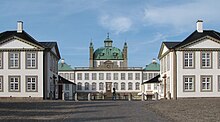Fredensborg Castle
Fredensborg Castle ( Fredensborg Slot ) is located in the north of the island of Zealand in Denmark . It is considered an example of the Nordic Baroque and “Danish Versailles ”.
history
King Christian V liked to use the area around today's castle for hunting. His son Friedrich IV had a small summer residence and hunting lodge built on the site of the Østrup farm between 1720 and 1722. The architect was the court gardener Johan Cornelius Krieger . The castle, which was still small at the time, had an almost square base, had only one and a half floors and was vaulted with a dome. The octagonal square in front of the castle was surrounded by low buildings for the servants. In keeping with the French and Italian styles, the castle was directly adjacent to the garden, which extends to the banks of the Esromsee . Krieger laid out the baroque garden along Christian V's hunting trails. The name Fredensborg ( Peace Palace ) to the between Denmark and Sweden concluded peace after the Great Northern War remember.
Christian VI. and above all Frederick V had the palace expanded. The main building was raised by two floors and supplemented by side wings. The buildings around the octagonal square were also increased. Fredensborg became the favorite residence of Friedrich V. Here he married his second wife Juliane in 1752 . From 1760 he had the adjacent park redesigned by Nicolas-Henri Jardin . After his death, Fredensborg became Julian's widow's seat.
Under Christian IX. Fredensborg became a popular holiday destination for European royal families. Even today, Fredensborg Palace is usually inhabited by the Danish royal family in spring and autumn; if the family is present, the changing of the guard takes place in front of the castle every day. While the interiors are only open for guided tours in July, the park is accessible all year round.
Prince Henrik (1934–2018), consort of Queen Margrethe II , died on February 13, 2018 at Fredensborg Palace.
Castle Church
In 1726 the castle was expanded to include the castle chapel. The architect was also Johan Cornelius Krieger. On some of the Corinthian columns the acanthus leaves have been replaced by elephant tusks, possibly a reference to the Elephant Order . The church and its furnishings are still largely in their original condition. Several members of the royal family were baptized, confirmed and married here. The church service for the parishes of Asminderød-Grønholt takes place in the church on Sundays. The ceiling painting is from 2006.
The organ in the castle church was built in 1848 by the organ builder Marcussen & Søn . The instrument has 17 stops on two manual works and a pedal.
|
|
|
||||||||||||||||||||||||||||||||||||||||||||||||||||||||||||||
See also
List of castles, chateaus and fortresses in Denmark
Web links
- Fredensborg Palace The Danish Monarchy website (kongehuset.dk)
Individual evidence
- ↑ a b Fredensborg Palace
- ↑ Fredensborg Palace Gardens
- ^ Death of HRH Prince Henrik. In: Website of the Danish royal family. February 14, 2018, accessed February 15, 2018 .
- ^ A b Fredensborg Palace Church
- ^ Fredensborg Palace
- ↑ Information on the organ of the castle church on the website of the organ building company
Coordinates: 55 ° 58 ′ 57 " N , 12 ° 23 ′ 43" E


